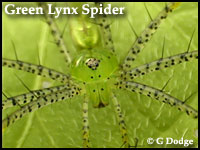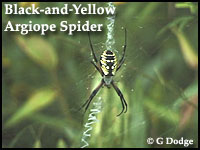Two spiders to look for in both August and September are the Green Lynx Spider (Puecetia viridans) and the Black-and-Yellow Argiope (ar-guy’-o-pee) Spider (Argiope aurantia). The lynx spiders may be found lying in wait on goldenrod, or other flowers, to pounce on nectar-loving insects. The Argiope, one of the most familiar orb weavers in our area, is often seen at this time of year waiting patiently on its web for hapless flying or jumping insects to ensnare themselves in the web.
August added another Dragonfly species to the Museum’s list of documented odes, a Spot-winged Glider (Pantala hymenaea). Spot-winged Gliders are close relatives of Wandering Gliders (Panatala flavescens), which also appeared during August, and are often seen in the same situations. Both are well know as migrants, and both can sometimes be seen in parking lots attempting to oviposit (lay eggs) on the hoods of parked cars, apparently thinking the car’s shiny hood a puddle of water.
The Spot-winged Glider that I saw on August 8 was at the Sailboat Pond in Catch the Wind ovipositing in the pond’s water.
A Bull Thistle next to the Sailboat Pond attracted Leaf-footed Bugs, a Differential Grasshopper, and a Chinese Mantid during mid-August. The Leaf-footed Bugs were there to breed, the Grasshopper to eat the plant’s leaves, as sparse as those leaves may be with their sharp spines, and the Mantid was drawn in by all the other insect activity.



Differential Grasshoppers are not listed as a species occurring in our area in one field guide that I consulted. However, besides the hopper on the thistle above, several were seen in the tall grass next to the Wetlands (north side). They are not uncommon. Another grasshopper spied at that location was a Clipwing Grasshopper (Metaleptea brevicornis), several in fact.

Adult Two-lined Spittlebugs, Net-winged Beetles (Calopteron), and Golden Tortoise Beetles made appearances during the early part of this period. The tortoise beetles were seen on the Morning Glory growing over the fence at the Red Wolf Enclosure. If you happen to be there admiring the wolves, take a minute to turn over some of the Morning Glory leaves, the ones with the holes in them, and you may get a surprise in seeing one of these small, brilliantly colored beetles.
In general, butterfly numbers increased during August. Sightings of Eastern Tiger Swallowtail and Spicebush Swallowtails were more frequent this month than had been in July, Sleepy Oranges were seen daily throughout the month, a Gray Hairstreakwas seen sipping nectar from Butterfly Weed, and Eastern-tailed Blues and Pearl Crescents were common. A Viceroy was observed on 8/14 and Red-spotted Purples were a daily sight on the Explore the Wild/Catch the Wind loop throughout the month. Skippers of various species were also more evident during August. A female Zabulon Skipper was seen on the 4th of August and a few Clouded Skippers on the 31st of the month.
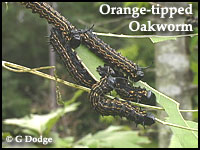 A small oak tree in Catch the Wind was stripped of its leaves by a colony of Orange-striped Oakworms (Anisota senatoria). First noticed by Richard Stickney of the Butterfly House on the 12th of the month, by the 18th the caterpillars had defoliated the tree and were crawling along on the ground in all directions searching for a place to pupate. I didn’t take a head count but there were certainly more than a hundred of the ravenous insects on the tree.
A small oak tree in Catch the Wind was stripped of its leaves by a colony of Orange-striped Oakworms (Anisota senatoria). First noticed by Richard Stickney of the Butterfly House on the 12th of the month, by the 18th the caterpillars had defoliated the tree and were crawling along on the ground in all directions searching for a place to pupate. I didn’t take a head count but there were certainly more than a hundred of the ravenous insects on the tree.
Red-humped Caterpillars (Schizura concinna) were observed munching on Redbud during the middle of the month.
Frass (caterpillar poop) led me to the best find of the period, a Luna Moth Caterpillar. The large green caterpillar was in a Sweetgum Tree. It pays to keep an eye out for frass as you walk along the paths of the outdoor exhibits at the Museum. I’ve noticed several other locations with this telltale sign of caterpillars feeding above, but haven’t been able to locate the culprits who deposited the small brown, cylindrical masses. As big as some of the larger moth caterpillars can be (up to 12 cm), they can be frustratingly difficult to find among the green leaves of trees, even when there are chewed leaves present.
During the third week of the Month there were three hot and muggy days when afternoon thunderstorms swept through the area. On one of those days, just following a heavy downpour, I noticed a strange insect (about 35-40 mm in length) crawling across the pavement next to the Wetlands in Explore the Wild. As I walked along I saw another, then another … dozens of these strange creatures were crawling across the path and away from the Wetlands.
The insect was dorsally flattened, had no legs and had a tube-like structure at the tip of its abdomen. I first thought “beetle larva,” or perhaps “Crane Fly larva,” crawling out of the Wetlands to pupate. Many beetle and most Crane Fly larvae are aquatic, and these creatures were certainly crawling out of, and away from, the water, or at least leaving the mud surrounding the water. But beetle larvae usually have legs, and the Crane Fly larvae that I’m familiar with are round in cross-section. What were these odd-looking creatures? Where were they going?
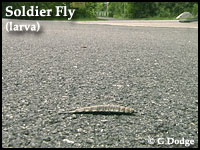 Craneflies are not the only diptera (flies) whose larvae are aquatic. Soldier Fly larvae are also aquatic, are legless, and when the time is right, crawl out of the water to search for a dry place to pupate. The insects that I saw slowly heading out across the pavement were Soldier Fly larvae, apparently in the genus Stratiomys.
Craneflies are not the only diptera (flies) whose larvae are aquatic. Soldier Fly larvae are also aquatic, are legless, and when the time is right, crawl out of the water to search for a dry place to pupate. The insects that I saw slowly heading out across the pavement were Soldier Fly larvae, apparently in the genus Stratiomys.
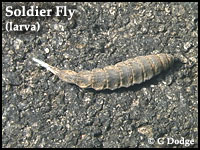 The question now is: Why were they, so many of them, on the move so soon after a heavy downpour? The ground was saturated with water. If they were looking for a dry place to pupate why not wait till the soil had dried out? Perhaps they had already crawled from the water to the banks and shoreline of the Wetlands and the heavy rain forced them to seek even higher ground. I don’t have a definitive answer to either question, but it seems reasonable that they were trying to get away from the flood in the Wetlands.
The question now is: Why were they, so many of them, on the move so soon after a heavy downpour? The ground was saturated with water. If they were looking for a dry place to pupate why not wait till the soil had dried out? Perhaps they had already crawled from the water to the banks and shoreline of the Wetlands and the heavy rain forced them to seek even higher ground. I don’t have a definitive answer to either question, but it seems reasonable that they were trying to get away from the flood in the Wetlands.
Cicada Killers were very active during August. I saw several females hunting cicadas in Catch the Wind, Explore the Wild, and along the Dinosaur Trail. I witnessed one of these large wasps subdue a cicada, then crawl up the side of a tree to a height of about twenty feet where I lost it among the leaves.
These wasps need to gain altitude before attempting the flight back to their burrows while carrying such large prey. They don’t always make it. They sometimes fall short of their burrow or drop the cicada en route. I’ve seen half-a-dozen dead, or perhaps paralyzed, cicadas while I was out walking the paths of the outdoor exhibits area. Are these cicadas ones that the wasps couldn’t hold on to while flying back to their burrows or had the cicadas simply expired on their own, neatly laid out on the pavement. Also, I’ve read that, as a defensive strategy, cicadas may play dead.
